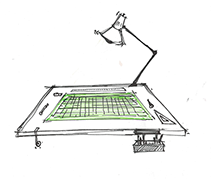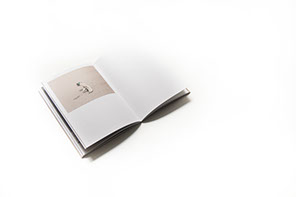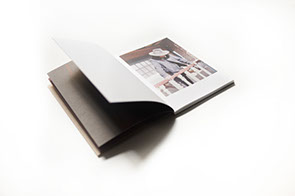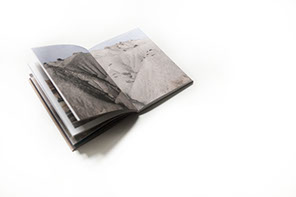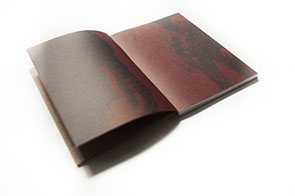
The book’s space
Imagine a book as a project, as a story, as an object
P: Which are the 5 indispensable pictures for this book?
The landscape.
Dreaming Leone started originally as a part of my research on landscapes of Andalusia: at that time I was working on a broader project about my native region. The majesty of landscape with the desert has strongly inspired me and probably it has been the same when they decided to set here the epic of Spaghetti Western.
The backdrop of the house.
It is the first picture that opens the main narrative of the book after the first 8 images which function as a sort of flash back. So, after the element of the script, the picture of the backdrop of the house represents a declaration of intention: we are talking about Tabernas as movie set, about its past glory and its decadence of these days. We believe the picture has a sort of poetic structure, it contains itself the beginning and the end of the story, it informs the relationship between reality and fiction. This is also why we transformed the photo in the logo of the cover.
The couple with the camper in the desert.
It is one of the most “documentary” picture of the project: it shows a Belgian couple who decided to settle down in the desert and live on performing country music shows. Like in the myth of “West”, they drop out of society and live as pioneers, wandering in the desert.
The man facing the backdrop.
Most of the people wandering in the sets are tourists looking for atmospheres, trying to match their memories from the movies with the scenarios around them. Memory is something you perform each time, according the input you have around you. We also consider this picture a sort of self-portrait of the photographer: it represents for us the complexity of the role of the photographer today, its capacity of transforming reality while witnessing it.
The cowboy shooting.
The picture is part of time-lapse series. In the book we had to confront with the idea of cinema itself, so we decided to put this sequence and play with it, twisting the meaning. Nowadays this stuntman has to perform his death 7 times at day for the public, in order to earn the same salary than in a Spaghetti Western movie production. We used the series as sort of punctuation in the book, and while doing this, we brought him back to the life and finally let him to shoot.
Thus it became a sort of “homage” to the idea of photobook itself: it’s the power released by sequencing images and by building relationship between them, which made a photobook a special object.
BD: What is the framed structure of this book?
DREAMING LEONE is a documentary project on the film industry in Almeria (ES), on its landscapes and inhabitants, and it aims to be a tribute to the figure of Sergio Leone and the imagery produced by the Spaghetti Western tradition.
In order to achieve an object able to deal with this visual legacy, the book has been constructed playing with the traditional iconography, using a specific aesthetics and having some elements as interventions in the book (like the case of the comics as well as the posters of the movies produced in there from the archives). The mix between the contemporary gaze of the photographer with these graphic elements, gives form to “Dreaming Leone”. According to our perception the photobook has to work as an activator in the viewer: bringing him back through the atmospheres of the most iconic scenes of the history of the cinema and at the same time questioning his sense of reality.
P: How did you choose your book designer?
I have knonw Michela Palermo since 2011, we have been both photographers in the same editorial agency, testing the editorial market, producing and selling stories for magazines. We were already familiar with our body of works and our photographic approaches. Basically I admire her attention and awareness about photobook as an art object: I’m a fan and collector of her selfpublished zines.
BD: What was your approach to get into the photographic project?
From the beginning we shared the same vision: we wanted to play with this connection with Sergio Leone and with what he left in the History of cinema. It has been a very fluid process, I have known Alvaro as photographer for many years and I had discussed with him the project many times before starting to work on the book. We decided to work on a special aspect of the project, and from this point we started to look for and collect other elements we thought able to comply our vision. Not all the elements that we found stayed on the book, most of them just functioned as scaffolder while we were constructing the narrative and then they disappeared when all the images found together their balance.
P / BD: How did you develop the work on the book?
We stole from cinema some figures of the narratives: the flashback as well as the element of the comics used as credit, quite common on the Spaghetti Westerns genre. The photographic work has been preserved in the simplicity of the layout and it was empowered by the dialogue created in the sequencing of the images. We didn’t have a linear narrative to process in the work, we were more focused on the atmospheres than in the story itself: so it came out almost naturally in its fragmented character.
The book as a story
BD: Which narrative slant did you choose for this book and why?
The book has a circular narration, it could be almost flipped on the both side, opening and closing with almost the same image (both images of a tree, stuck in the desert, almost suspended in a time it doesn’t exist anymore, and probably never existed). But the viewer can be able to retrace more than one backstory, wondering more and more about Tabernas and its inhabitants.
P: What’s the difference between the book and the photographic project slant?
The former idea of the photographic project was to talk about the film industry in Almeria, and its decadence of these days followed the Golden Age of the 70’s and 80’s -when almost 300 movies were shot each year- compared to nowadays when the sets are abandoned or just reduced to a sort of fun fairs.
With the book we left behind the documentary approach, and we stepped into a more evocative approach. We found the strength of the story in the metaphor of the “West” able to deal with what we do believe contemporary issues of our times. We believe man tries to find a certain dose of fiction but not for a well-known necessity to evade but because he needs to find out about “the possible”, apart from the real, what has been left out or could have been (and has not).
Thus in a historical landmark of the crisis and limited horizons – the economics crisis, the rising idea of closed borders, the concept of violence and its representation- the imaginary of the West is still a projection of a possibility, the sign of a frontier spirit. And for sure the self-publish gets along well with this idea.
The book as an object
BD: How did you choose the materials and the kind of printing?
The concept of the book has been thought very similar to the concept of comics, another shape in which the epic of the Western took form.
The soft cover, as well as the use of uncoated paper perfectly matches with our vision of constructing a “memorabilia”. For the photographic part we have intentionally chosen a type of paper with a tactile character. The choice of offset was made in relation to the limited edition.
P: How the materials’ choices are connected to the photographic project?
The smoothness of the paper gives to the pictures a new quality, reducing contrast for example. And all the roughness of the book has something to do with this spirit of the West.
